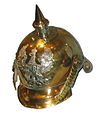Fittings (uniform)
In the military jargon of the German-speaking countries until the end of the First World War, fittings were the metal decorations on helmets and shakos used by the police , the military and the fire brigade .
These are the emblems attached to the front, such as national coats of arms, guard stars, name ribbons (fatherland bands), the borders of the front and neck shields and the helmet rail attached to the pimple hood as a stiffener . The fittings were made of nickel silver or tombac . For the officers of some units, they were made of silver or gold-plated brass. Officers who did not belong to these privileged associations could also equip themselves with it. Since the clothing regulations of the time for self-dressing were handled very generously (this applied to both Germany and Austria-Hungary ), all soldiers could, as far as they were financially able to do so, provide themselves with the equipment reserved for officers ( one-year-old- Volunteers , officer cadets and reserve officer cadets were required to dress themselves.).
With some units, such as the Bavarian Chevaulegers , two regiments wore the same badge color. They only differed in the color of the fittings.
The helmet tip or ball, the necessary fastening parts such as a clover leaf or disk, the other ornaments attached to the helmet (lions or eagle figures) and the scale chains could differ in material from the fittings.
literature
- Jürgen Kraus "The German Army in World War I / Uniforms and Equipment" Verlag Militaria, Vienna 2004



